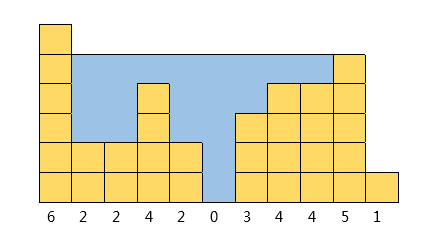题意
Description
现有一堆边长为1的已经放置好的积木,小明(对的,你没看错,的确是陪伴我们成长的那个小明)想知道当下雨天来时会有多少积水。小明又是如此地喜欢二次元,于是他把这个三维的现实问题简化成二维的问题。设雨量无穷、积木不透水、积木间无缝连接,问在这个二次元的世界里,已放置好的积木会有多少单位的积水量?
Input
第一行包含一个整数T(T≤100),表示接下来的测试样例个数。 每个测试样例有两行组成: 第一行包含一个整数N(N≤1e6),表示积木的列数; 第二行包含N个整数Ai(Ai≤1e6),表示第i列积木的个数。
Output
每个样例输出一行,包含一个整数,为题目所求。
Sample Input
1
11
6 2 2 4 2 0 3 4 4 5 1
Sample Output
19
思路
数据范围是10^6,显然不能O(n^2)。
不自然的就想到了栈。
维护一个递减的栈。
如果,当前列比栈顶列低,那就入栈。
否则,就一直出栈,直至栈顶高于当前列。
理由是显然的,对于两个相对高些的列,它们之间的较低列显然是没用的。
最后,所有列都进行过后,对栈里元素依次出栈,并记录它们之间的矩形面积,再减去它们之间的方格总数,既是最终的答案。
代码
#include <stdio.h>
#include <iostream>
#include <string.h>
#include <stdlib.h>
#include <algorithm>
#include <stack>
using namespace std;
#define LL long long
LL d[1000009], g[1000009];
int main()
{
int T, n;
scanf("%d", &T);
while(T--)
{
scanf("%d", &n);
for(int i=0; i<n; i++)
scanf("%d", &d[i]);
g[0] = d[0];
for(int i=1; i<n; i++)
g[i] = g[i-1] + d[i];
stack<int> s;
LL ans = 0;
for(int i=0; i<n; i++)
{
if(s.empty())
{
s.push(i);
continue;
}
int t;
while(!s.empty())
{
t = s.top();
if(d[t] > d[i])
break;
s.pop();
}
if(s.empty())
ans += (i-t-1)*d[t]-(g[i-1]-g[t]);
s.push(i);
}
if(!s.empty())
{
int i = s.top();
s.pop();
while(!s.empty())
{
int t = s.top();
s.pop();
ans += (i-t-1)*d[i]-(g[i-1]-g[t]);
i = t;
}
}
printf("%lld\n", ans);
}
return 0;
}
